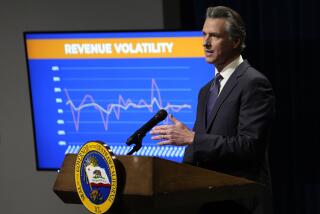Wilson Borrows a Chapter From Bill Clinton’s Playbook
- Share via
As Gov. Pete Wilson entered the Assembly chamber to deliver his seventh State of the State address last week, political observers wondered which voice would they hear.
This had nothing to do with the governor’s recurring throat problems. Rather, it relates to Wilson’s pattern of ideological and political shifts throughout his tenure as chief executive.
Would this year’s outline of policy priorities reflect the confrontational conservatism of the failed 1996 presidential candidate? Or would the more moderate rhetoric of 1991, with calls for activist, “preventive government,” resurface?
As it turned out, the voice heard at the Assembly podium was, by and large, that of the early governor, but without the spark. There was just a nod to the tough-on-crime rhetoric that dominated the governor’s policy pronouncements in the past few years. Echoes of Propositions 187 and 209 were faint.
In essence, what was heard was really not so much Wilson I as Clinton II. The chastened, lame-duck governor, forced by circumstances and politics to work on intractable problems with a Legislature controlled by Democrats, sounded much like the chastened, lame-duck president, forced by circumstances and politics, to work on intractable problems with a Congress controlled by Republicans.
Wilson’s speech even featured a Clintonesque focus on the concerns of anxious middle-class voters--education, drugs, gangs. California’s “daddy-in-chief” is as attentive to truancy and teen-age drug abuse as is the nation’s. He has downsized preventive government, just as Bill Clinton has downsized activist government. Wilson’s agenda includes few sweeping initiatives and visionary goals.
On one major issue--welfare reform--Wilson abandoned moderation. His hard-line proposals to end “welfare’s warehousing of people who don’t want to work” are red meat for the right. Yet, they are not out of step with current voter opinion. They are a strong reminder that the parameters of this year’s address, and the get-tough welfare budget that followed, were determined by governmental necessity as much as by political efficacy.
Despite an increase in revenues because of the state’s economic comeback, California’s history of ballot-box budgeting continues to limit the flexibility of the governor and the Legislature to define spending priorities. Nowhere is this clearer than in the mandate of Proposition 98, the voter-approved initiative that allocates a minimum of 40% of the budget to public schools. That’s money that can’t be shifted elsewhere--not to prison construction, welfare benefits, flood relief or infrastructure repair.
The battle over education funding will likely revolve around where and how this school money is spent. By touting local-control initiatives, such as education vouchers and charter schools, and pushing support for computers and classroom construction, rather than teacher-salary increases, Wilson seeks to capitalize on a politically popular issue--even most conservative districts support smaller classes and “education reform”--while moving to end-run the teachers’ unions, which have long been Democratic allies.
But the political fight that will tie Sacramento in knots will be over how to implement the new federal welfare law. This is the one issue on which Wilson and the Democratic legislative majority must come to terms, or risk losing federal funds. Already, responses are hardening along partisan lines.
The GOP-driven initiative, signed into law by the president last August, abolishes welfare as a system of permanent support by limiting recipients to a life-time cap of five years of assistance and to no more than two consecutive years of benefits. Wilson wants to go beyond this and impose tougher aid requirements and stricter time limits. The Legislature’s most powerful Democrat, Senate President Pro Tem Bill Lockyer (D-Hayward), has labeled the governor’s plan “a menu of punishments, rather than a safety net for the least fortunate in our state.”
Another sure-to-be-contentious issue is Wilson’s proposal to relieve the counties of their legal responsibility to be the “safety net of last resort” by allowing them to eliminate or reduce General Assistance benefits. Some hail this as welcome relief for cash-strapped local governments, many of which worry that the new law will flood county relief rolls, as legal immigrants and other welfare recipients lose federal aid. But ending the state mandate could adversely affect high-cost, high-caseload, urbanized counties, particularly Los Angeles County, never a political favorite of Republican Wilson. A top Senate Democrat characterized the governor’s proposal as “not doing away with the problems, just the money to address the problems.” Legislative Democrats are already warning that they will oppose lifting the mandate unless “some kind of statewide safety net” is provided.
Democrats cannot go too far in opposing Wilson and the Republicans on welfare reform without incurring some political damage. And any California budget must be crafted to gain a two-thirds vote for passage and the governor’s signature, which means Republicans and their conservative goals cannot be ignored.
Besides, the lesson learned by Newt Gingrich and House Republicans during the 1995 federal budget negotiations is instructive: Never let yourself get caught on the unpopular side of a funding issue. To be perceived by voters as a wild-eyed radical, bent on threatening popular programs, is dangerous to a politician’s professional health.
Wilson has long understood that, in politics, positioning is almost everything. He has learned, through his recent stint in the national arena, that timing and tone count for a lot, too. That’s why we heard the governor deliver this year’s State of the State in a voice modulated to reflect a different time, a different politics, and a different Wilson.*
More to Read
Get the L.A. Times Politics newsletter
Deeply reported insights into legislation, politics and policy from Sacramento, Washington and beyond. In your inbox twice per week.
You may occasionally receive promotional content from the Los Angeles Times.










